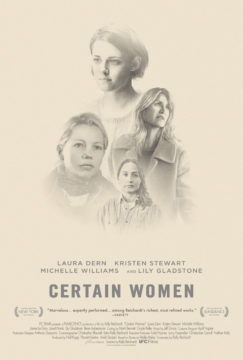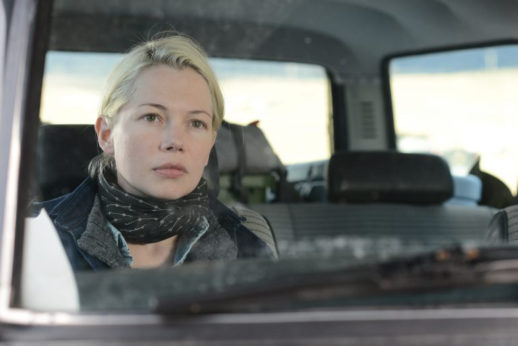Variety
Guy Lodge 1/24/2016
Sundance Film Review: ‘Certain Women’
Kelly Reichardt’s wonderful triptych of female character studies confirms her status as the quietest of great American filmmakers.
Few contemporary filmmakers can do quite as much with quiet as Kelly Reichardt. Superficially empty soundscapes are layered so intricately with the rustle of nature, the brooding of weather and the breathing of preoccupied people that her films come to seem positively noisy to a sympathetic ear. So it is in the marvelous “Certain Women,” where the storytelling has a similarly latent impact. Separating the spare narratives of several disparate Montana women — a morally stressed lawyer, a nest-building mother, a lonely ranch hand — waiting indefinitely for their worlds to fall into place, it’s a peculiarly riveting examination of the lives lived when even their owners aren’t looking. Crafted with Reichardt’s customary calico-textured beauty and expertly performed by such hand-picked ensemble players asKristen Stewart, Michelle Williams and Laura Dern, this unapologetically open-ended slow burn probably won’t convert many viewers to Reichardt’s softly-softly sensibility, but it’s among her richest, most refined works.
Like a number of Reichardt’s previous films, “Certain Women” has its roots in the short-story format — one naturally conducive to her flair for teasing larger lives and deeper longings out of passing everyday incidents. Her literary inspiration this time is Montana-based author Maile Meloy, with Reichardt’s elegantly apportioned script drawn from her stories “Tome,” “Native Sandstone” and “Travis B.” The director’s chosen title, however, is at once calculatedly vague and mournfully ironic. Read one way, “Certain Women” implies a kind of unnamed randomness to Reichardt’s chosen female subjects, as if any number of adjacent women’s lives might have been equally worthy of the film’s attention. Read another, it’s perhaps a gentle joke at the expense of characters for whom certainty is in achingly short supply: It’s hardly a spoiler to say that none of the pic’s delicate strands hinges on anything like a drastic dramatic decision.
Viewers accustomed to the knotty “Short Cuts” school of multiple short-story adaptation may take a while to acclimatize to the film’s patient, clean-edged structure, which opts neither for explicit chaptering nor for intricate braiding of the three stories in question. Revelation-concerned narrative splicing has become such a familiar feature of the U.S. independent filmmaking scene that it’s positively bracing to see Reichardt — also acting, with graceful discernment, as her own editor — unfold her mini-dramas one at a time, letting the sometimes faint connections between them emerge with little fanfare, revisiting their principal characters only in the final reels. If Paul Haggis’s “Crash” literalized the idea of storytelling as automotive collision, “Certain Women” prefers to let its vehicles pass each other with an acknowledging wave — apt enough for a film in which human contact doesn’t come easily to the yearning, inward-looking women at its center.
To describe the film’s individual segments on paper is not to do them many favors, even when they include such notionally hefty events as an armed hostage situation — as staged by Reichardt, returning to her trademark tender humanism after the icy genre stylings of “Night Moves,” surely the lowest-key such standoff in cinematic history. The first story centers on small-town lawyer Laura (Dern), introduced in the postcoital stages of an afternoon tryst with a married man — whose identity lends passive emotional complexity to a later section. He gives the impression of a decent self-confident man, although he takes Viagra. Focus shifts to a legal case that has become something of a thorn in her side, as construction laborer Fuller (Jared Harris, devastatingly ragged) obstinately pursues an injury claim that a legal technicality prevents him from winning. Taking little heed of her counsel — because she’s a woman, Laura concludes with the weariness of experience — he implicates her in a more violent course of action.
Cut to Gina (Williams), discontentedly wrapping up a rural camping weekend with her husband, Ryan (James Le Gros), and perma-sullen teenage daughter Guthrie (Sara Rodier). Fatigued by tetchy family life, she pours her efforts into constructing a symbol of idealized domestic unity: a woodland weekend cottage that she intends to build, with preciously modish integrity, entirely from repurposed native materials. Yet this ostensibly noble goal entails a degree of selfish manipulation, as she and Ryan press on doddery family friend (Albert) to sell them the reserve of vintage sandstone on his property.
Drily satirizing the opportunistic exploitation of tradition in the American heartland, Gina’s story is the most coolly oblique of the three. What follows is the most bittersweetly open-hearted, as a nameless Native American horse rancher (the revelatory Lily Gladstone) aimlessly seeks a personal connection at an adult education center. Stumbling by chance into a class on educational law for teachers, she develops an intense but innocent fascination with its young tutor, Beth (Stewart), a socially awkward law graduate who lives many towns over. The two develop a mutually bemused rapport over post-class diner meals, though when Beth abruptly quits the job, the terms of their new, ambiguously platonic romance become harder to parse.
There are no tidily concrete thematic ties to be found between these slender, piquant slices of life, though all touch on the generalities of human alienation and solitude for which E.M. Forster issued the poetic prescription to “only connect.” As with Reichardt’s more streamlined miniatures, regional detail accounts for much of the film’s lingering resonance, as her characters are molded by (and, in some cases, rail against) the landscape they inhabit. “Certain Women” is the director’s fifth film to be set against the pregnant skies and cornbread-colored grasslands of America’s Northwest — painted with misty iridescence on 16mm by Reichardt’s reliably brilliant cinematographer Christopher Blauvelt — and there’s a not-wholly-rueful sense here of indigenous tradition and etiquette passing into history. All the women here, however put-upon, are independent in ways that defy their staid surroundings.
Though this is arguably the most illustrious ensemble Reichardt has ever had to hand, the pic’s performance style is as casually organic and democratic as in any of her more scrappily cast early projects. There’s complete onscreen parity, for example, between a relative newcomer like Gladstone and a megawatt star like Stewart — both unobtrusively superb — while Williams, in her third collaboration with Reichardt, underplays with terse modesty. Playing most recognizably to a star persona is Dern, if only because said persona has been built on the kind of creased, empathetic decency that makes her a Reichardt natural.
Top | Link
The Guardian
Nigel M Smith 1/25/2016
Certain Women review: Kelly Reichardt returns melancholy yet triumphant
The indie auteur reunites with Meek’s Cutoff star Michelle Williams for a deeply-involving slow-burner also featuring Kristen Stewart and Laura Dern.
Kelly Reichardt had proven herself a master at slow-burning, melancholic dramas with Old Joy, Wendy and Lucy and Meek’s Cutoff. She switched gears with the eco-themed thriller Night Moves: a relatively mainstream feature that moved at a faster pace than her preceding work. Her latest, Certain Women, an adaptation of short stories by Maile Meloy, sees Reichardt tackle a contemplative ensemble drama that recalls the solemn tone set by her earlier work.
Fittingly, it reunites her with her Wendy and Lucy and Meek’s Cutoff muse, Michelle Williams, who plays one of the four women that populate the three interwoven vignettes set in and around Livingston, Montana.
The first opens with what seems like the end of an adulterous tryst between lawyer Laura Wells (Laura Dern) and a gruff, handsome man named Ryan (James LeGros). Once at work, she’s surprised by a visit from her client, Fuller (Jared Harris), who’s seeking compensation for an office accident. Refusing to take Laura’s advice that he has no case, she agrees to bring Fuller to a male lawyer who offers the same counsel. Unable to accept defeat, Fuller takes matter into his own hands, bringing Laura along for the ride.
Ryan is revealed to be married to Gina (Williams), in the second and chilliest chapter. The pair, along with their bored teenage daughter Guthrie (Sara Rodier), are camping near a plot of land on which the couple intent to build a house. On their way back to the city, the family make a stop to visit Albert (Rene Auberjonois), an old family friend, in an effort to persuade him to sell some vintage sandstone for use on their new venture, that he no longer has use for.
The third section section is the most nakedly emotional of the trio, centring on a Native American horse rancher (the wonderfully expressive Lily Gladstone), who seems to have no human interaction in her life while caring for her horses on a remote ranch. That changes when she happens upon a class on education law in the nearest town, and takes an immediate liking to its instructor, Elizabeth (Kristen Stewart), an overworked law-school graduate who commutes a long distance for the job. Over a number of post-class diner meals the pair bond, with the unnamed ranch hand soon believing their connection to be a romantic one.
Like Reichardt’s directorial hand, the performances are understated across the board, but deeply felt. Gladstone conveys a heartbreaking sense of yearning, while never verbally stating as much. Dern and Williams, playing women who face sexism over the course of their two storylines, simmer under the surface with palpable anger. And Stewart continues to impress, following a revelatory performance in Clouds of Sils Maria, as a young woman seemingly oblivious to the effect she has others.
Together, they form an indelible portrait of independent women at odds with their rural surroundings.
Top | Link
Indiewire
Noel Murray 1/25/2016
Sundance Review: Kelly Reichardt’s ‘Certain Women’ Starring Michelle Williams, Kristen Stewart, And Laura Dern
At one point during the development of Kelly Reichardt’s “Certain Women,” the film was called “Livingston,” a title that refers to the small Montana town where most of the movie takes place. The name-change is provocative, suggesting that Reichardt intends to say something very specific about gender. And there are definitely scenes in “Certain Women” to support that. The movie’s divided into three sections — each anchored by a female protagonist, and each based on a short story by Guggenheim fellow Maile Meloy — and in each of the first two, there’s a moment where the main character talks to a man who barely seems to register anything she says. In the Montana of this movie, women are independent and headstrong, yet still undervalued.
But it’d be reductive and inadequate to define “Certain Women” strictly in terms of what it might be “saying.” The film’s three parts have the qualities of great literary fiction and of refined art-cinema. Reichardt is primarily concerned with capturing Meloy’s highly specific characters, and the landscape they populate. There’s a lot to be picked up here — about the loneliness of people separated by the American Northwest’s vastness, and about being a good steward of both a land and its history. Then again, a person could get a lot out of staring at an artfully composed photograph of Montana, too. For Reichardt, the aesthetics matter as much as the theme.
“Certain Women” is a deliberately slow-paced film, though not undramatic. The first segment stars Laura Dern as a small-claims attorney who’s become exasperated by her most difficult client: a skilled handyman (played by Jared Harris) who refuses to understand that while a former employer is responsible for his current disability, they’re legally absolved of paying him any more workman’s compensation. The third segment stars Lily Gladstone as a horse-rancher whose attraction to a stressed-out recent law-school grad (Kristen Stewart) begins to cross the line from sweet to stalker-ish. Both of these stories feels like they could evolve at any time to something violent or tragic — and both actually do build to a confrontation of sorts, although Meloy and Reichardt avoid cheap payoffs.
The most emotionally complex of the three sections though stars Michelle Williams as Gina, the mother of a snippy teenage daughter and the wife of an unfaithful man (James Le Gros), who’s trying to alleviate his guilt somewhat by building her a house out in the country. Gina has decided that she wants him to use as much natural and local material as possible, so she and her husband ask a feeble elderly friend named Albert (Rene Auberjonois) if they can have the pile of sandstone that’s been sitting out in front of his house for years. He responds by launching into a monologue about the origin of the stone, turning what seems like a simple request into a complicated statement on what it means to be a Montanan — and what it might mean to his identity to give these rocks away.
That conversation between Gina and Albert is the most blatant example in “Certain Women” of a man not really paying attention to a woman. On the other hand, it’s part of the overall style of this film for people to speak past each other — and usually after uncommonly long pauses. Although the dialogue and delivery are fairly realistic, the beats that Reichardt encourages between lines makes the characters’ interactions feel less natural. Like the director’s earlier films — “River of Grass,” “Old Joy,” “Wendy and Lucy,” “Meek’s Cutoff,” and “Night Moves” — “Certain Women” is so hushed and halting that it’s bound to turn off some viewers.
The structure may assuage some of the Reichardt-averse. Because no one segment runs much longer than 30 minutes, the film changes focus often enough to avoid overkill. And while the way each part trails off may initially seem unsatisfying, Reichardt helps out by giving each a coda in the movie’s last 10 minutes — which, in the case of the Dern/Harris story, is essential to clarifying what it’s all about. Though “Certain Women” is difficult, it’s hardly obtuse.
And for those willing to trust that Reichardt is in full command of this material, “Certain Women” is utterly enthralling. The glacial storytelling has a mesmerizing effect, and also gives audiences time to drink in the big skies — against which the humans look so insignificant — and to appreciate the careful way that Reichardt establishes what Meloy’s heroines are up against. The cold, the distance, the arduous labor, the subtle class divisions, and the unwelcoming men… all of these help define why these certain women are the way they are. [A-]
Top | Link
ABOUT THE PRODUCTION
Livingston, Montana; located on the Yellowstone River and flanked by the Absaroka mountains, the town with a population of just over 7,000 is the setting for three stories of independent women finding their way through daily struggles that range from the mundane to the life-changing. Based on short stories by Maile Meloy, Certain Women is brought to life by acclaimed independent filmmaker Kelly Reichardt.
This is the sixth feature film for Reichardt, and the fifth set in the American Northwest. Departing the Oregon settings she explored in Old Joy, Wendy and Lucy, Meek’s Cutoff, and Night Moves, the wide-open Big Sky country and the landlocked, isolated landscape of southern Montana provide a profoundly beautiful and entirely appropriate backdrop for the characters and moments that constitute the three stories in the film. “This was the first time I’ve spent a lot of time and made a film in a location that is not on a coast,” Reichardt observes, “and that gives this film a completely different feeling. There are mountains on all sides of you, which in many ways locks you in, and I think that really changes the way you might look at the world.”
Looking at the world from that unique perspective is what links the three stories adapted by Reichardt: Native Sandstone and Tome were from Meloy’s 2003 debut Half in Love, and Travis, B. in 2009’s Both Ways is the Only Way I Want It. The latter book earned acclaim from the New York Times as one of the ten best books of the year, and was on Oprah magazine’s summer reading list in 2010 (“…the nuanced depictions of small-town life…make for a rich tableau of lovelorn cowboys, provincial lawyers, and renegade women.”) Drawing favorable comparisons to literary legends like Flannery O’Connor and Raymond Carver, Meloy’s stories (many set in Meloy’s hometown of Helena, rather than Livingston) “erupt from a volatile combination of the tender and the vicious…[as] gentle, deer-in-the-headlight protagonists are stunned by the escapades of their daring, outlandish, and even outlaw intimates,” as the reviewer from Booklist enthuses.
Reichardt has already made several films based on short stories, and found herself inspired by how the setting and the characters in three particular stories fit together. “I knew I wanted to shoot somewhere else, so I liked that the stories were based on Montana,” she remembers today. “I was drawn to the story about the rancher first, about her life struggles, and her isolation. This person’s daily chores, her connections to the animals – all of those things drew me in.” When the rancher finds herself unexpectedly drawn to the itinerant teacher who visits the town twice a week, it leads her to a series of realizations and actions that seem to gain a momentous resonance as circumstances change.
Other filmmakers have been inspired by short stories or shorter-form narratives as the basis for feature films – think of Robert Altman’s Short Cuts (based on several stories by Raymond Carver) or the overlapping narratives of Jim Jarmusch’s Mystery Train. But in assembling these three stories, Reichardt took the unusual approach of presenting them fully and sequentially, rather than intertwining them. There are moments where the stories overlap – characters from one story very briefly cross paths with characters from the others – but each story is afforded its own distinct space to play out. Rather than linked by specific plot points, they are linked by the quality of the characters who, like their environment, are textured, nuanced, layered, and subtle. Ultimately, Reichardt feels that the choice to keep the stories distinct helps capture the depth and intensity of the characters: in stories that lack traditional “action” or “high stakes” (at least according to contemporary cinematic standards), lingering with the characters in their moments of indecision, contemplation, and resolution became imperative. “These weren’t stories that you could leave and come back to,” Reichardt says plainly.
For Reichardt, that also meant sequencing the stories effectively to capture the range of experience between the characters. The first and last stories are about people who are native to the location – residents who reflect the static, but still overpowering feeling that embodies the feeling of the land around them. It was the middle story, featuring Michelle Williams and James Le Gros as a couple hoping to take a pile of sandstone away from an elderly neighbor, that provides the link between the two. “This was a story of outsiders coming in and moving into this new area,” the director explains, “and it fit so nicely between the other two stories where the characters are of that world.”
Initially looking for locations around Helena, Reichardt and longtime producing partner Neil Kopp expanded their search to other areas of Montana that would serve the production not only from a story standpoint, but visually. Moviegoers familiar with Reichardt’s work know exactly how much location, light, and landscape serve as key elements in her film, as the visual impact of the images, often rendered in loving, patient detail, underscore the more subtle elements of emotional conflict that characters often cannot express directly through dialogue. Reichardt was drawn to Livingston because of the way the town is surrounded by the Rocky Mountains and the way the high altitude and northern latitude could be seen on film. “The light is so different; the mountains seem much bigger, and they feel closer in, but it’s a bare landscape. They call it ‘big sky’ for a reason.” It is also a setting which proved to be more sensory than expected. Reichardt recalls that producer Kopp initially wondered how “different” the remote Livingston felt from more accessible or familiar locations, “but after leaving I don’t think any of us thought that,” she concludes. “The moisture is very different – and it’s also one of the windiest cities in the country. We arrived on the first day and the wind was howling and almost blew us over, but that’s typical Livingston weather.”
Living in the area for over three months, including thirty shooting days, was a challenge well met by the production team’s experience. Kopp is just one of Reichardt’s team who have been with her for over a decade, and also includes producer Anish Savjani and executive producers Todd Haynes and Larry Fessenden (add to that list cinematographer Christopher Blauvelt, working with Reichardt for the third consecutive project). “All of these films have taken a lot of creative thinking on Neil and Anish’s part,” Reichardt says, “Their tenacity and being up for that kind of challenge has been very lucky for me.” Still, her colleagues are not above suggesting that Reichardt at some point think about making different creative choices. “They keep asking me – will you please write a script that takes place in the summertime?” Reichardt jokes.
The weather indeed became a factor as production began. The most remote location is the rancher’s homestead, and logistics dictated that it was the sequence that would be shot first (though it is last in order in the final film). The horses that Lily Gladstone’s unnamed character attends to were not animal actors, but actual horses on a very remote ranch who were unused to seeing any human except a caretaker or two. “I wanted to spend time there to understand that life – the daily chores, the way of life – as well as to look at the light and locations that would reflect that character’s world,” Reichardt says. “But when we started production, we really used a very basic skeleton crew, and had to add people slowly so the horses wouldn’t freak out.”
There was also the last-minute decision to shoot the film on 16mm after a debate about using digital. Being in a remote location meant that looking at processed film dailies would be difficult. “But when we did some test shooting on digital, the layers of snow on the ground looked like a white wall – there was just no detail,” Reichardt remembers. Capturing the rancher’s world effectively would mean the more cumbersome 16mm. That’s when the movie weather gods interfered. “When we did our test shoot and preproduction, it was mild and snowing. The day before we started actual production, the weather changed, and it went to freezing with no snow – everything that was white had turned brown.”
Ultimately, the stories in the film were shot in reverse order, partially to accommodate the schedules of the actors involved and take maximum advantage of their availability. Reichardt has forged a solid collaborative relationship with actor Michelle Williams, herself a native of Kalispell, Montana, and previous star of Reichardt’s Wendy and Lucy (which earned Williams an IFP nomination and Online Film Critics Society Award for Best Actress) and Meek’s Cutoff. James Le Gros, as well, had worked with Reichardt before in Night Moves. But many actors were new to Reichardt’s team, and quickly found ways to contribute and mold their performances to Reichardt’s cinematic style. Despite being used to bigger budgets, Reichardt was impressed by her cast’s professionalism. “There wasn’t any hump or period of adjustment with any of them,” she says. “My crew is really together, everyone was always on the same page, and everyone knows that everyone else is contributing in small ways. It was very easy to make people comfortable, and having Michelle and James around as the familiar faces during the middle of production also helped.”
It’s easy to describe Kelly Reichardt’s films as “small” compared to Hollywood blockbusters and even some higher-profile indies. She’s more likely to invoke comparisons to legendary way-out-of-the-mainstream filmmakers like Jon Jost or Wim Wenders than she is her generational peers. But Certain Women continues her examination of real people facing situations in almost real time, against the backdrop of real locations and places that both define and confine characters and their actions. Exploring the nuanced moments of these women’s lives, from impossible conversations with difficult men, to awkward pauses where communication fails, to private and unseen actions that are almost miraculously rendered through silence and stillness, Certain Women magnifies Reichardt’s technique as it is echoes from scene to scene, character to character, and story to story. Even when characters can’t seem to speak for themselves, the film’s delicate and thoughtful rendering of these strikingly observed and very human stories manage to speak volumes to viewers in a manner that is unique to one of the cinema’s most disciplined and expressive voices.









